Measures
We perform a lot of conservation measures between July 2014 and December 2020 to improve the conservation status of the oak-hornbeam-forests and the connected habitats.
Which bat species do inhabit the Villeforests?
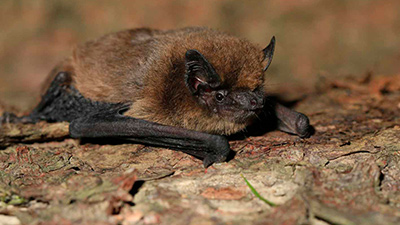
In 2015 and 2016 we explored the bat species of the Ville Forests. Our old oak forests harbour 12 of the 17 North Rhine-Westphalian bat species. Six species use oak or beech cavities as maternity or sleeping roosts. We found three maternity colonies of the endangered Bechstein's bat in the Ville Forests. In 2019 we started a second survey to explore the impact of the convervation measures.
 How to restore the natural water balance of the oak-hornbeam forests
How to restore the natural water balance of the oak-hornbeam forests
The network of drainage ditches in the Ville Forests was already established in the 18th century and recently repaired and deepened in the 1980s. In 2015 we optained an expert opinion to assess the effects of the ditches and to choose appropiate conservation measures to ensure favourable living conditions for pedunculate oak, hornbeam and small-leaved lime. Since 2016 we closed 55 kilometer of drainage dichtes on an area of 530 hectare.
How to enlarge the area of protected forest habitats
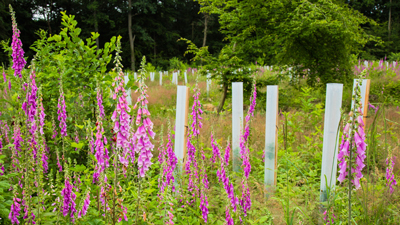
The conversion of the non-native spruce and pine forests into oak-hornbeam forests is a long term task. A lot of conifer forests have large gaps in consequence of windthrows or attacks of pests like bark beetles. Since 2015 we have planted 260.000 oaks, hornbeams, limes and beeches into these gaps. Mountain ash, birch, wild cherry and willow will join without planting, so that a species-rich and multilayered mixed oak forest will grow up.
How to preserve an high amount of biotope wood in the managed deciduous forests
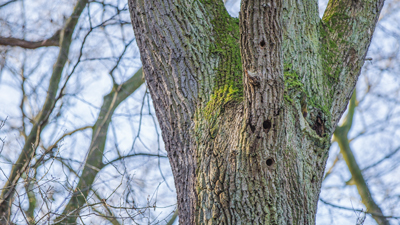
In the winter 2015 to 2017 we mapped the habitat trees in all oak and beech forests of the project area. We marked trees with cavities and horsts, standing and lying deadwood and old-growth trees with microhabitats like lightning cracks, branch demolitions and dead branches. In cooperation with the local forest officers we selected single trees, groups of trees and set aside areas excluded from timber production. These trees will remain in the Ville Forests as a habitat for woodpeckers, bats or saproxylic beetles.
Why do we purchase woodland?
We purchased five hectares of private forests. We selected old-growth deciduous forests with a great value for nature conservation and conifer forests that will be conversed to connect existing oak-hornbeam stands. An entry in the land register is made to preserve these forest areas for nature conservation.
Why do we re-establish coppice with standards?
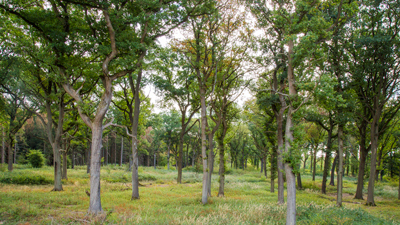
Coppice with standards is a traditional silvicultural system in the Ville Forests practiced from the middle ages to the 19th century. Our ancestors harvested the hornbeam and lime trees every 20 to 30 years as firewood and used single old oaks as constructionwood. These open forests harbour a species rich flora and fauna. The scattered old oaks have large canopies with a lot of deadwood branches, which are habitat for woodpeckers an saproxlic beetles. We resumed this traditional forest management system on an area of 39 hectares.
Where and how will new amphibian ponds be created?
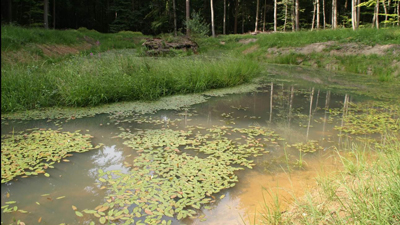
As a first step we assessed the conservation status of all existing ponds of the Ville forests and surveyed their amphibian fauna. Based on this data we decided where we had to establish new poods or restore existing ones. Since 2016 we have created or restored 70 forest ponds as habitat for amphibians like great crested newt (Triturus cristatus) and agile frog (Rana dalmatina). The new ponds will have an area of 150 sqm and a depth of 1.2 meters each.
How to restore biodiverse meadows
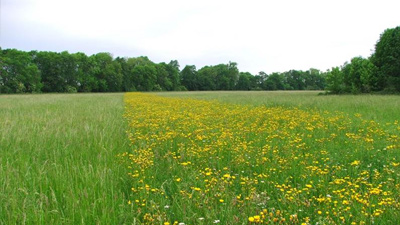 The enhancement of forest meadows to species-rich lowland hay meadows was carried out in several steps. At the beginning we selected 17 areas which have a high development potential because of the occurrence of rare and characteristic grassland species. In winter 2014/2015 they were enlarged to a minimum area of 2000 sqm. After that we established grassland species by transferring hay from a species-rich donor meadow, sowing local seeds and planting out rare species (e.g. arnica). The forest meadows had to be fenced to avoid damage by wild boars.
The enhancement of forest meadows to species-rich lowland hay meadows was carried out in several steps. At the beginning we selected 17 areas which have a high development potential because of the occurrence of rare and characteristic grassland species. In winter 2014/2015 they were enlarged to a minimum area of 2000 sqm. After that we established grassland species by transferring hay from a species-rich donor meadow, sowing local seeds and planting out rare species (e.g. arnica). The forest meadows had to be fenced to avoid damage by wild boars.
How to inform the local population
Since 2014 we have informed the public about our conservation measures and the biodiversity of the Ville Forests. More than 2.500 people have joined our lectures, guided tours or treeplanting events. Watch our video to learn more about our oak forests.





